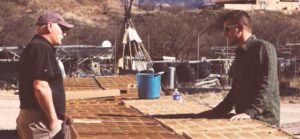Arizona Mining drills 17 feet of 22% zinc, 14.8% lead and 3.8 oz/ton silver

 Arizona Mining Inc. [TSX-AZ] has reported results of four exploration drill holes from its current program on the Taylor zinc-lead-silver sulfide deposit located on its 100%-owned Hermosa Project in Santa Cruz County, Arizona. This brings the total number of drill holes reported in the 2016 program to 41.
Arizona Mining Inc. [TSX-AZ] has reported results of four exploration drill holes from its current program on the Taylor zinc-lead-silver sulfide deposit located on its 100%-owned Hermosa Project in Santa Cruz County, Arizona. This brings the total number of drill holes reported in the 2016 program to 41.
HDS-353 is a significant step-out hole drilled approximately 1,700 feet southwest of the boundary of the previously reported resource. The drill hole intersected three distinct carbonate replacement deposit (CRD) hosted stratabound mineralized horizons and one high-grade zinc-lead-silver vein. The CRD and vein mineralization occurs in the middle member of the Scherrer Formation (a significant ore host at Taylor). Three well mineralized CRD zones were intersected in the drill hole including a 32-foot thick interval assaying 12.2% zinc, 8.2% lead and 2.3 oz/ton silver. Included in the zone was a higher-grade, 17-foot thick interval grading 22.0% zinc, 14.8% lead and 3.8 oz/ton silver.
HDS-387 is a vertical hole drilled to infill an untested area on the northeast margin of the previously reported resource area. The drill hole was successful and clearly indicates continuity of the mineralization in the northeast area of the resource. HDS-387 intersected seven distinct mineralized CRD horizons with a total cumulative mineralized thickness of 276.5 feet. Several mineralized zones were intersected in the drill hole including a 41.5-foot thick interval assaying 11.1% zinc, 21.8% lead and 7.5 oz/ton silver, which occurred within a larger interval 112.5 feet thick which assayed 5.4% zinc, 9.6% lead and 3.2 oz/ton silver.
HDS-382 is a low angle (-60 degrees) core hole drilled to infill the resource to the southwest. The drill hole intersected eight mineralized zones totaling 251 feet of mineralization and infilled a gap in drill coverage. The most significant interval from the drill hole was an 87-foot thick zone high in the carbonate sequence which assayed 9.6% zinc, 10.5% lead and 4.7 oz/ton silver. Deeper down the hole, the drilling intersected a 10-foot thick interval within a broader zone of mineralization 29 feet thick, which assayed 3.3% zinc, 7.4% lead and 2.3 oz/ton silver.
HDS-386 was drilled to test an area along the northeast boundary of the patented claim block. The drill hole intersected four significant zinc/lead/silver veins in the volcanics and two CRD intervals in the carbonates. The CRD intersections indicate continuity of the mineralization in the area of the drill hole extending northwest from HDS-354. One of the veins intersected in the volcanics assayed 4.8% zinc, 26.8% lead and 26.5 oz/ton silver over 2.5 feet; however, the true thickness of the vein is believed to be less than 1.5 feet. The most significant CRD interval in the drill hole was a 51-foot thick intercept assaying 0.6% zinc, 3.0% lead and 3.9 oz/ton silver.
Arizona Mining CEO, Jim Gowans, said, “As we prepare for the preliminary economic assessment, which is planned for the end of Q1 2017, the drilling continues to deliver excellent results for both the infill and expansion of the Taylor deposit. The drill results and advanced metallurgical program currently underway will underpin the study.”
See company website for assay tables.
The Taylor deposit, a zinc-lead-silver carbonate replacement deposit, has a resource of 31.1 million tons in the indicated resource category grading 10.9% zinc equivalent (ZnEq) and 82.7 million tons in the inferred category grading 11.1% ZnEq, both utilizing a 4% ZnEq cutoff grade calculated in accordance with NI 43-101 guidelines. The Taylor deposit remains open to the north, west and south over land controlled by the company and will be drilled to test the limits of the resource. The company’s other project on the Hermosa property is the Central deposit, a silver-manganese manto oxide project.
